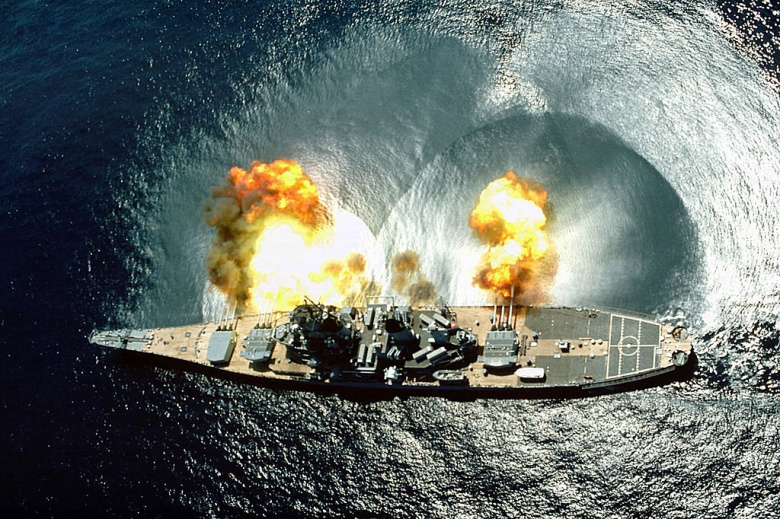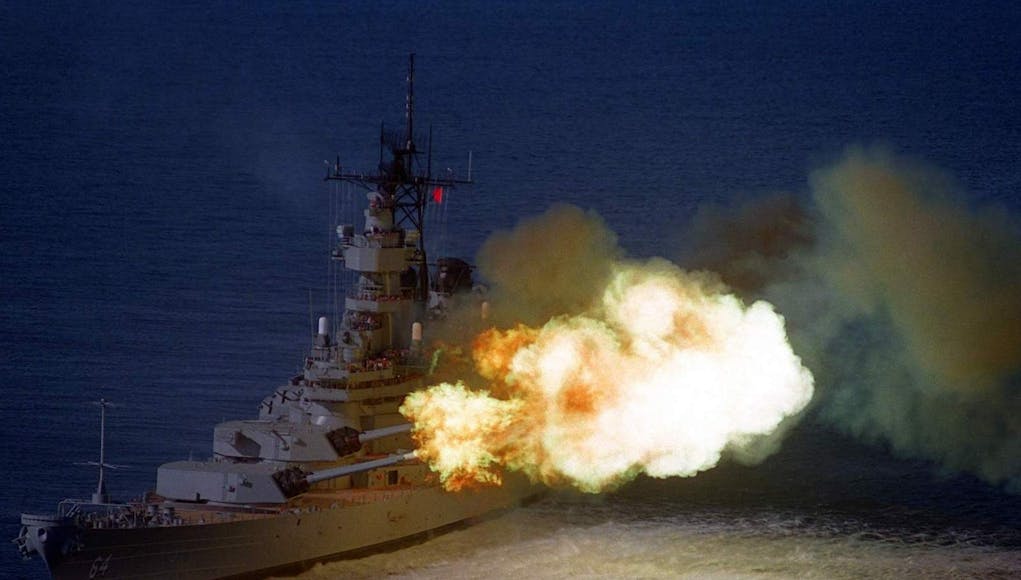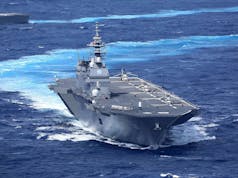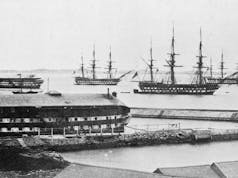This article explores the role of the Battleship and whether or not the vessel still has a place at sea.
Recently we published an article titled ‘The End of the Battleship: Why Britain needs Aircraft Carriers’ by Sam Flint which argues that the United Kingdom needs to invest in the capabilities of Aircraft carriers and these ships have replaced battleships as capital ships.
These are the ships in which to measure a nation’s strength. I would agree with this argument in part, but I think there is are added benefits to having a battleship or ‘battleship-like’ ships which is has the same capabilities and shore bombardment potential without the tonnage displacement, the crew needed or the big calibre guns such as the Zumwalt class.
I know this is a controversial point to be made, but I do argue that battleships do bring something to the battlefield, that other ships don’t. However, I later qualify my points in terms of projection of power rather than the ship itself is what is needed.

The National Interest (2017) published a piece called ‘Battlecarrier: The US Navy’s Dream of Merging a Battleship and an Aircraft Carrier’. This is an interesting read and would encourage others to look at this article to form their own opinions.
The battlecarrier concept from this article is summarised below:
“The firepower of the battleships—and their destructive range—would have increased substantially. Trading one turret for 20 Harrier jets was a pretty good deal. Add the Tomahawks and their ability to strike with precision at a thousand miles and the improvements looked even better. The resulting warship would have equaled the firepower of a Nimitz-class supercarrier.
But as before, the Iowas’ inherent inefficiencies worked against them. With a crew of nearly 2,000 each, the ships’ high personnel costs made them prohibitively expensive to run in an all-volunteer navy. Harrier jets could already be carried by the Tarawa-class landing ships, and missile silos were proliferating across the fleet.”
Concept model of the ‘battlecarrier’ below
Alternative depiction of this hybird concept below with ‘harrier’ jumpjet aircraft:
In some ways this mirrors what the Soviet Union attempted to do back in the 1970s when they were building the ‘hybrid cruiser-carrier concept’.
Below is a Soviet ‘Kiev-class’ cruiser-carrier hybrid.

But it does have its limitations. However I think it interesting the ‘Battlecarrier’ concept is interesting, and whether it still has the place in the 21st century.
Historically it is worth noting that during the 1990 – 1991 First Gulf War Iowa class battleships took part in Operation Desert Storm.
The USS Missouri was well known for firing Tomahawk cruise missiles which was shown on international news. There is a whole debate called ‘United States Naval Gunfire Support debate’ which you can even read on Wikipedia, but basically exponents of this debate argue that the US Navy needs to be able to deliver shore bombardment during a time of war.
However, there are those who would argue that nowadays, other ships can do this, through surgical strikes, and the battleship is no longer needed when you have technologically sophisticated Arleigh-Burke destroyers as well as aircraft such as B-52s, and surgical strikes from stealth fighters.
After the days of the Cold War, cost cutting, and accountancy meant that these old ships were retired from service with full military honours, with their nuclear warheads and tomahawk cruise missiles removed. The Soviet Union collapsed and with it its naval threat. The maritime landscape had changed. This meant the battleships became redundant in an age of peace, without a foreseeable enemy to need these ships for.
Even mass media and Hollywood have an idealistic view of the Iowa class in the aptly named Hollywood film called ‘Battleship’ (2012) loosely based on the board-game. In one scene, Lt. Alex Hopper (Taylor Kitsch) is a weapons officer aboard a US destroyer when it got hit, and needs to take the helm of the USS Missouri an Iowa – class ship (which has since been decommissioned and is now a museum) in order to take the fight direct to the Alien ship.
The display of its analog displays, its massive guns, and the way it moves was ‘naval porn’ for those who are into their ships. The message in ‘Battleship’ was, that in the end, all it takes was a few big guns to launch a the enemy – in this case an Alien ship. This is all Hollywood fiction, and to a point you have to take this with a pinch of salt. I agree, but there is a symbolism in our culture, and reverence for the Battleship.

I would personally say, that battleships are essential in warfare. The battleship can carry a multitude of different munitions including ballistic missiles, nuclear capable missiles, and also has anti-submarine and anti-aircraft capabilities.
It can be a massive missile boat, plus during an amphibious landing its big guns could take out targets if need be. The battleship and offshore bombardment could be seen as necessary and essential to destroy deep fortifications, and to destroy bunkers. But could this be done by another class of vessel already designed?
The answer is yes.
The firepower of battleships will be seen in the Zumwalt-class destroyers, which would provide fire naval support for Marines. You could argue that these are the 21st century equivalent to the Iowa class battleship, but has the cost-benefit advantages of being smaller manned, not as big, stealth like capabilities, and precision firepower.
In addition, I can see ships being designed to launch effective deadly missiles at bunker and command-control complexes, with the mission profile of shore bombardment. While the B52 is still in service some would argue why can’t the Iowa class? The truth of the matter is that the nature of warfare itself has changed. I predict that we will witness the emergence of a new class of destroyer such as the Zumwalt class style of ‘‘missile battery’ ships with a specific focus on land attack.
Below is a Zumwalt-class destroyer concept art.

However, one cannot discount the continuous debate that has followed since the last Iowa class retirement. The argument being the need to provide shore bombardment support for the Marine Corps. Historically, this was also why these decommissioned Battleships were not broken up, or made into museums following their retirement from service. Both the USS Iowa and the USS Wisconsin, were stricken from the Naval Register in the mid 2000s. In theory, these ships could have participated in the Second Gulf War: Operation Iraqi Freedom if deemed necessary, but they didn’t.
While the Foxtrot Article (2015) article argues that at least the USS Iowa, and USS Wisconsin could be project power once again in a Trump naval build up, like they did during the Reagan era of the 1980s. However, I do wonder if Trump may, and this is one big possible may, reactivate these ships for symbolic reasons. Trump’s rhetoric of ‘Make America Great Again’ maybe will give an added political impetus to restore these battleships for its added symbolism and visions it conjures up to potential adversaries, but for military reasons I do not believe this is necessarily the right path to follow.
I doubt parking an Iowa class battleship in the South China Sea would deter the People’s Republic of China, or deter North Korea from developing more missiles. Times have changed.
I would therefore conclude, however we personally feel about the battleship, whether it’s nostalgia, or reverence for the actions they have provided in the past, they are essentially analog ships which could not logistically operate in a digital era. The manpower needed, as well as the refits, and new computers and operating systems, and power stations would be immense.
I would go so far as to say that there is neither the political will, or the military impetus from naval strategists and planners from many nations to reactive the ‘Battleship’ as a viable concept in the 21st century. That is why we do not see a single battleship in operation today. The focus is on stealth, smaller crew, precision missions, and the mission profile to avoid detection. All of these variables, would be incompatible with a battleship.
However, there is one lasting thought to leave on. There have not been any large naval engagements in a time of war since Falklands War, and any other naval engagements has been ship to shore. Future warfare may provide lessons – particularly in amphibious warfare of what is needed.
The Zumwalt class is an interesting testbed for the future of offshore naval bombardment, and I believe we will see this play out in a future conflict.



















Just imagine the Bismark with additional protection and projection? That would have been a formidable prospect for any opposing enemy. Today, that method of warfare would still work, just as with the B52, which refuses to die due to its adaptability, and principal purpose to bomb with a variety of weapons. I for one see a modern battleship with massive guns (possibly rail type) and immense size and structured armour protection made from heavy and lightweight composites. Such ships could hold station for months if not years anywhere around the World’s oceans. From those anchorages it could command other vessels,… Read more »
As the last living “Plank Owner” of the battle ship New Jersey BB63 , I was part of the team that recommissioned it in 1967, & 6 year Tin Can sailer & 10 yr. as a Boiler Maker w/ American Ship Building Co. I have very specific knowledge regarding war ships of any class. I believe that Iowa class ships could be totally refitted with nuclear power, made lighter, faster, better armoured do to modern materials. They would be platforms for any updated weapons. The likely hood of another ship to ship sea battle ever occurring is almost non-existent, however… Read more »
The short answer is “no”. I think the US Ohios converted to cruise missile subs are a real asset, however. I think we should look at cruise missile ships – modifying freighters to carry hundreds of them. They would give us the ability to position a ship offshore that could affect activities on land to a much greater range or depth than a battleship might with even rocket-assisted projectiles. Constructing one would likely be far less expensive than building a battleship or ssgn. Granted, our astutes can carry thirty or so cruise missiles in addition to a modest load of… Read more »
I’ve thought the same about converted freighters and the US Navy did look into it as well, I believe they called the concept “Arsenal Ships”. I think the main prohibition is the cost of the missiles themselves, the vulnerability of such ships is also an issue although you could treat them like carriers, meshed in with the same supporting fleet a carrier receives they would be similarly vulnerable. Most US warships don’t deploy with full missile loads which probably goes some way to explaining why a ship that is entirely focused on missile capacity didn’t take off.
The object of military action is to neutralise the opposition, hopefully by giving up their will to resist or it in the worst case by destruction. The advent of accurate munitions and delivery systems removed the need for huge amounts of munitions in the hope some of them hit the target. At the battle of Jutland only around 2.5% of shells fired actually hit their targets, accuracy of modern munitions is in excess of 80%. Some UK warships achieved an accuracy of less than 1%. The day of the battleship is over, the jury on whether aircraft carriers can survive… Read more »
I believe the cruise missile sub is a viable concept. For example USS Florida, a Ohio class former SSBN can carry 154 cruise missiles. Parking one of these leviathans “near” a coast line can be considered a massive force multiplier. In the UK we are now looking to replace the Vanguard with the Dreadnought class. Even though the boats are getting on a bit. Like their US cousins it would be a awesome opportunity to convert a number to cruise missile carriers. It will probably never happen due to our non existent defence budget. However, there is a downside to… Read more »
Will rail gun technology change the calculus of the Battleship? Will guided projectiles, perhaps with small integrated solid fuel rockets do the same? What about lasers and hypersonic missiles? Perhaps in time, the former three will merge and we will see guided, hypersonic shells with hundreds of miles of range, high repetition rates and the ability not only to act in an air-defence role but also provide strategic strikes? I think we will find that the argument will fragment and that people will come to see the answer may be different depending on the requirements of the mission and the… Read more »
Zumwalt is a non event, too expensive, you have one and that is all you are going to get.
There are three
The main benefit of a Battleship type vessel is actually its armour, providing the ability to take a great deal of punishment. Although the huge guns of WWII era battleships are now considered short range for ASuW, they still had the capability to deliver a shell with a large amount ordnance travelling at a very high velocity. The hitting power of such legacy weapons is in the same league as current anti ship missiles. The Battleship was designed to sustain several hits from such weapons. Current warships are unable to sustain much battle damage, with relatively delicate electronics and thin… Read more »
The battleship was a vast sink of capital expenditure, that were only worth the vast expense and effort because they were the apsolute expression power at that time, a nation without a battleship could not compete at sea with a nation that had battleships. The moment it became obvious that they could not compete against carrier borne aircraft or submarines they became pointless white elephants, their whole purpose destroyed. The shore bombardment role was a sad shadow their purpose and could never justify the vast costs. Modern battleships are a bit more diverse and make up ships you must have… Read more »
Times are changing, the battleship was rendered obsolete by air power, in fact for a while surface naval vessels of any description faced that threat. Then along came SAM defences which have now improved to the point that by all accounts attacking a naval vessel with aircraft and missiles is a pointless adventure. Submarines whilst still the silent killers are susceptible to destruction by airpower, modern anti submarine warfare systems make a sub’s job just as dangerous as it was in WW2. A massive ship, with both airpower contingent and missile contingent capable of absorbing huge damage and heavily compartmentalised… Read more »
There seems to be some confusion over the shore bombardment role. This was the province of monitors – think 10,000 tons, 10 knots and 10 feet draught, mounting one battleship gun with a leisurely rate of fire, but much cheaper – and needing few crew. With modern fire control systems they could destroy shore targets very efficiently and cost-effectively, leaving the blue-water fight to more sophisticated (and expensive) warships.
No way……easy to hit and high value target for nothing.
The same moment that there are high range air-weapons and easy to transfer & relocate, witn no track on the radar and low cost.
Sorry but it is not a good idea !